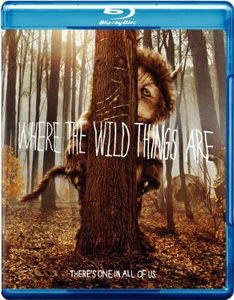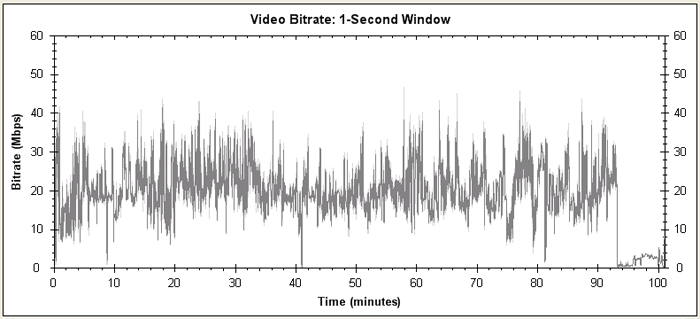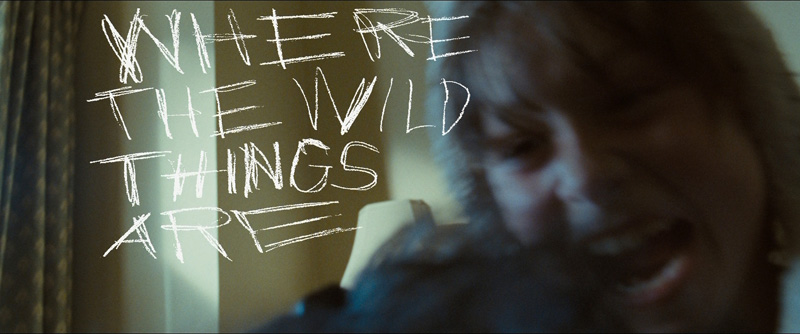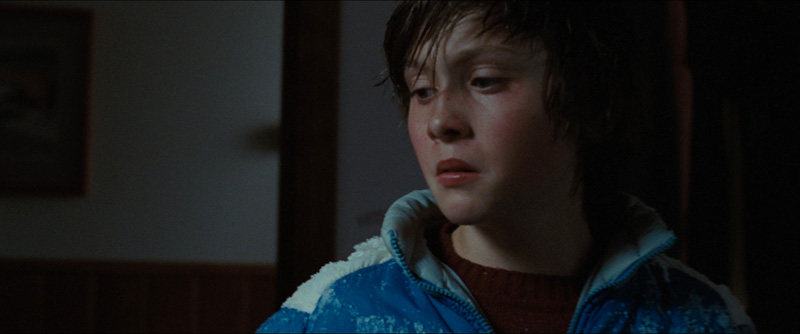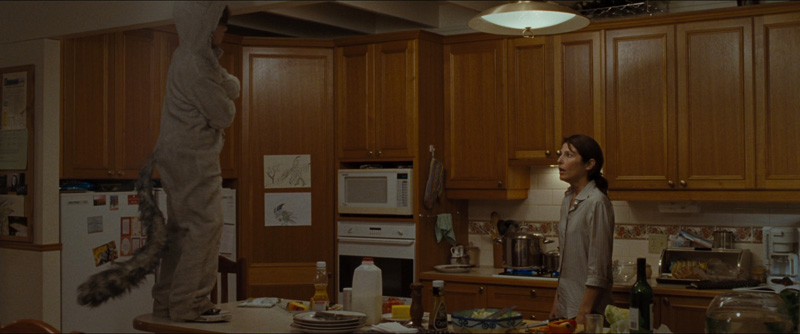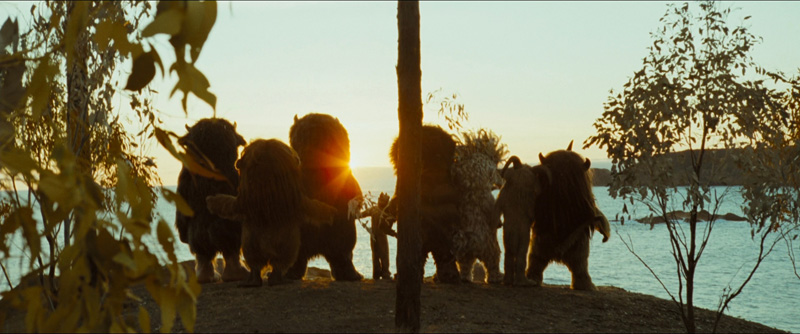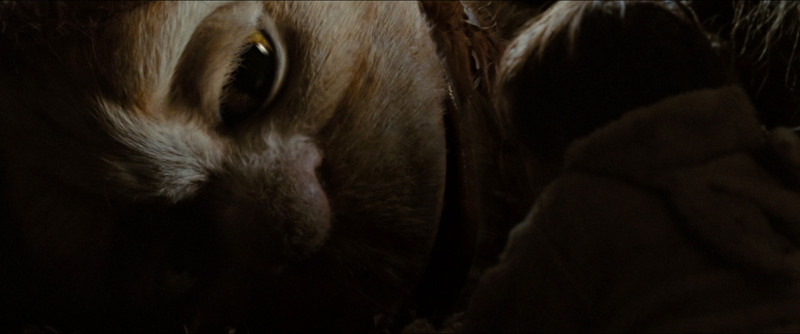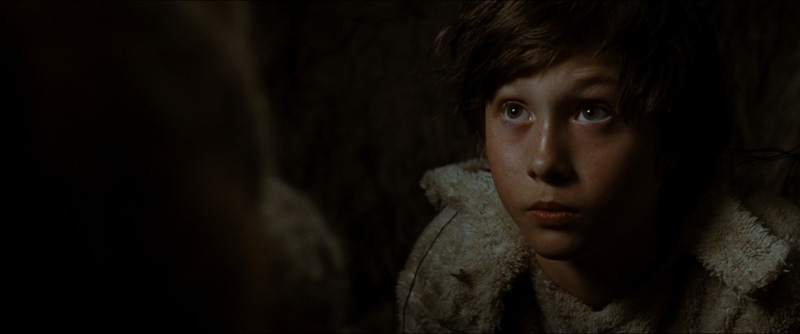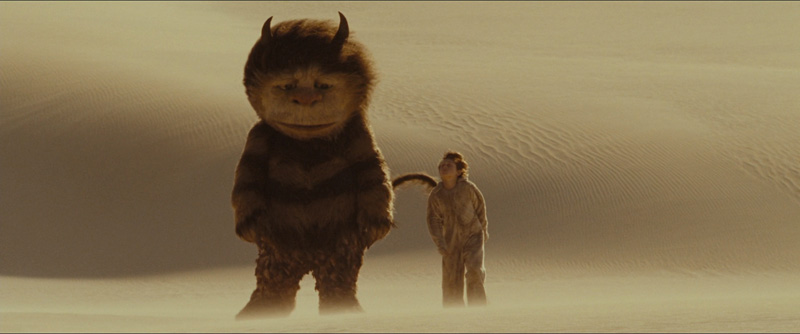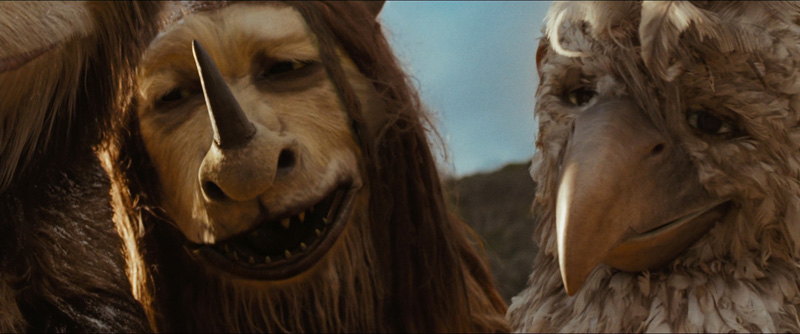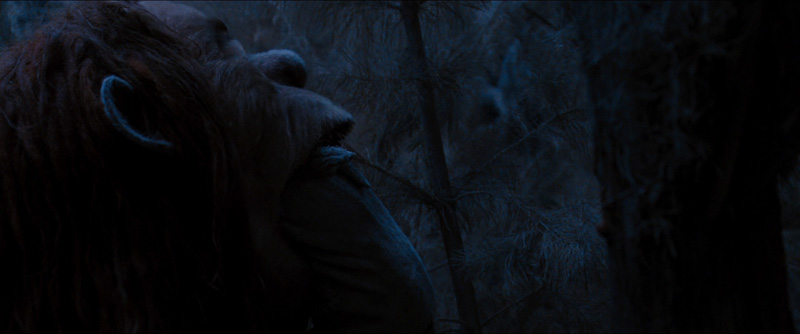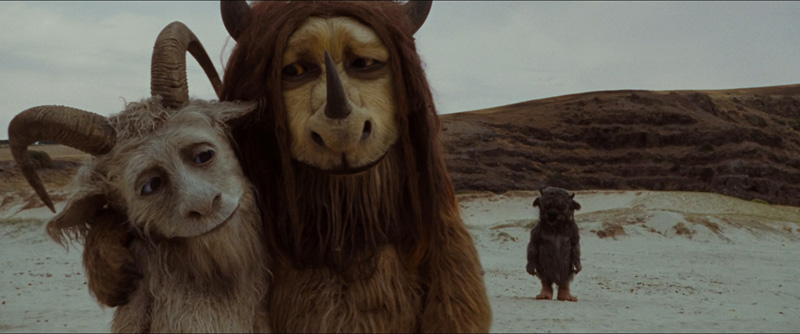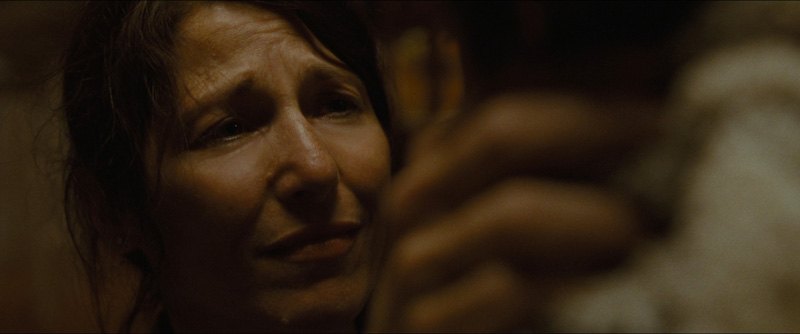|
Where
the Wild Things Are [Blu-ray]
(Spike Jonze, 2009)
Review by Leonard Norwitz
Studio:
Theatrical: Wild Things Productions
Blu-ray: Warner Video
Disc:
Region: FREE!
(as verified by the
Momitsu region FREE Blu-ray player)
Runtime: 1:41:01.930
Disc Size: 29,321,197,125 bytes
Feature Size: 20,098,578,432 bytes
Video Bitrate: 19.12 Mbps
Chapters: 26
Case: Standard Blu-ray case w/ 2 discs
Release date: March 2nd, 2010
Video:
Aspect ratio: 2.35:1
Resolution: 1080p / 23.976 fps
Video codec: MPEG-4 AVC Video
Audio:
DTS-HD Master Audio English 3831 kbps 5.1 / 48 kHz / 3831
kbps / 24-bit (DTS Core: 5.1 / 48 kHz / 1509 kbps / 24-bit)
Dolby Digital Audio French 640 kbps 5.1 / 48 kHz / 640 kbps
Dolby Digital Audio Portuguese 640 kbps 5.1 / 48 kHz / 640
kbps
Dolby Digital Audio Spanish 640 kbps 5.1 / 48 kHz / 640 kbps
Subtitles:
English (SDH), English,
French, Portuguese, Spanish,
none
Extras:
• Higgelty Piggelty Pop! – in HD (23:26)
• HBO First Look – in HD (13:00)
• 8 Behind the Scenes Shorts – in HD (ca. 55 min.)
• Digital Copy Disc
The Film:
6
Not unlike how a movie such as Avatar, with its incredibly
immersive imagery, might make us credit it with more
substance than it has, so, perversely, I found Spike Jonze's
Where the Wild Things Are less absorbing than it might have
been otherwise simply because it is so dull to look at it.
Not only does the lighting intentionally place Max and his
wild things so often in shadow, but even the overall
sharpness up for grabs.
Spike Jonze and Dave Eggers rethinking of Maurice Sendak's
classic children's book could be thought of in developmental
terms as about sharing, control, autonomy – all things that
a latency age kid, especially a boy, needs to have in place
if he – or she – is to graduate to adolescence. The
protagonist here is Max (Max Records), who is not so good at
dealing the loss of a father, the sharing of space with a
sister who fails to defend him when she should, and a mother
who, though evidently caring of Max, needs to make some
space for own needs as well.
One night, after a particularly hard day at boyhood, Max
runs away from home in his trademark furry wolf suit. His
travels take him across the sea in a small boat, where,
following a perilous storm he comes across a small island -
uninhabited, it seems, except for a handful of outsized,
stuffed creatures. Not only do these Wild Things speak – in
English, thankfully – but they are even less civilized than
young boys at play. Being large and particularly unruly,
they are more than a little dangerous and even threaten Max
with dinner – theirs, of him.
In boylike fashion, Max sees this business as opportunity to
create the rules of engagement as he goes along, first
convincing them, begrudgingly I might add, that he is a king
from a distant land and then to accept himself as theirs.
The problem is that, while real boys at real play, can opt
out at any time, our creatures can't.
When Max first comes upon the creatures, they are already in
the middle of an ongoing family quarrel, and Carol (James
Gandolfini) is breaking up homes along with small portions
of the forest. In some ways the tribulations faced by each
of the beasts is a reflection of some aspect or other of
Max's life – writ large and interminable. But when it comes
right down to it, these guys aren't all that much fun. They
are depressed and cynical – Judith, especially,
skin-crawlingly voiced by Catherine O'Hara. Despite how they
talk about things, the creatures are surprisingly concrete
and unimaginative (except for Carol's artistic abilities),
and they always manage to find the stormy side of any cloud.
Rainbows for them aren't an option. We are sure that this is
how Max sees himself at home, though he obviously has
significantly more going for him there than his subjects in
the woods.
For a movie about – and possibly for – children, there were
times I had the feeling I was watching Who's Afraid of Carol
& Judith meets Waiting for Godot. I was painfully aware of
how much the deck is stacked against Max, and the stackers
are the screenwriters, (certainly not Sendak, whose text
could be read in about three minutes – if you're slow.) Max
is portrayed as a kid, about nine or ten I'd guess, without
friends. And though his mother (sensitively nuanced by
Catherine Keener) loves and cares for him, Max won't give
her room to add another man to his life (thank you, Oedipus,
for your contribution to child development). Max sees
himself as about as lonely as a kid can get (we might see
him as petulant if he weren't so darn cute) – and one that
has no options other than to mope about or destroy things.
Max has an older sister with whom he once felt some
closeness but who has gone on to enjoy riding around in cars
with boys who can drive them.
One day, Max engages Claire and three of her friends in a
surprise snowball fight, which everyone eagerly joins in –
until it gets out of hand and one of the bigger kids crushes
Max's snow tunnel into a drift, with Max in it. The gang
leaves the scene of the crime without comment, but the boy
who did the damage lingers for a moment, as if wondering if
he should acknowledge some sort of unintended hurt. He
decides not, and having done so won't permit himself to let
Claire so much as a wave goodbye to Max. Ah, the pangs of
adolescence – where one is unable to acknowledge the most
perfunctory of apologies to a ten year old.
This is a painful moment in the movie, as we see Max as
having no one to soothe his loss. We don't know why he has
no friends his age (in school, he remains in his own head),
especially in that he is so evidently charming and engaging
when he chooses. Given the circumscribed world Max lives in,
I ask myself: Is this a universe worth living in? Is it any
wonder that Max is angry and runs away? In the book, he
retires (without any of this backstory) to the safety of his
room where he can safely enter world where he can express
his rage and deal with it as he chooses.
In the movie, he takes his leave altogether into a dream,
like so many, that touches on nightmare. He finds a place
where unbridled fury is the order of the day. Yet he is
reluctant to join in at the same level as that of the
inhabitants. He quickly resorts to managing their pain. He
negotiates, makes promises, and even when he proposes
all-out war, it all comes to more pain, even loss.
Ultimately, Max must return home, not so much as Sendak
describes it, for comfort and reassurance, but because he is
unable to put things right or to make others happy. (Since
when is this a child's job!) So, unlike Sendak, who
envisions a place to go where a child can go to safely and
creatively express his fury, Jonze imagines a place where a
child goes to learn how to try to make everyone happy and
fail at the attempt. I don't get it.
Image:
6/8
NOTE:
The below
Blu-ray
captures were taken directly from the
Blu-ray
disc.
The first number indicates a relative level of excellence
compared to other Blu-ray video discs on a ten-point scale.
The second number places this image along the full range of
DVD and Blu-ray discs.
I found myself completely flummoxed by the image quality of
this Blu-ray, even long before Max arrived at his magical
island. I usually find some way to explain choices about
lighting, filtration, lensing and art direction, but not
here. I was never able to come to grips with the question of
why the image is so unengaging. There is hardly a frame
where I didn't question if there wasn't something amiss.
Backlighting is very strong, and there is a resistance to
fill lit, especially for Max, that struck me as downright
pig-headed. Where we can see things "in the light" so to
speak, there is a decided lack of detail and texture.
In the deep recesses of the forest, there is a kind of
brightening that undoes the darkness. Grain is often
present, but, again, I fail to see why it's there in the
first place. Not only is the image is a gross
contradistinction to Sendek's fine line drawings, it strikes
me as unfantastical, and certainly unwhimsical. The
creatures looked somewhat more precise than Max, which was
just as troubling for me, as if they occupied two different
universes – which in a way, I suppose they do – but somehow
I couldn't make them converge.
Ed. - Unlike Leonard, I don't own the disc but I did see
this theatrically and remember a LOT more grain than I am
seeing in any of these captures. They also look soft -
although it is probably NOT DNR smearing. It's hard to be positive as I
may be misremembering and don't have the
Blu-ray
to scrutinize - but, to me, this image looks unusually flat
and, possibly, over-processed. I concur with Leonard in that
I don't really like what I am seeing regardless of it
potentially being a purposeful effect or style.
CLICK EACH
BLU-RAY
CAPTURE TO SEE ALL IMAGES IN FULL 1920X1080 RESOLUTION
Audio & Music:
8/8
It is Carter Burwell's excellently contrived, dynamic and
rollicking filmscore that I found wincingly at odds with DP
Lance Acord's more naturalistic and rather bland imagery.
The music - together with some wonderfully exaggerated
galumphing in a "wild rumpus" through the woods, trees
falling, huge dirt clods hitting their marks, and more
proportional, but equally scary waves crashing about the
little boat that Max commands – is presented in one reality,
the images in another. Despite sensible attempts to alter
dialogue soundspace for different scenes (forest, beach,
desert, tunnels), I couldn't shake the feeling of a
disconnect between the monster's voices, their physical
manifestations and Max. I had less trouble if I closed my
eyes, so I'm thinking it has something to do with accepting
Gandolfini and company as the speaking creatures they are
supposed to be. This is by no means to criticize the audio –
far from it – but to try to express how the disparity
between audio and image made it difficult for me to accept
Jonze's universe in toto.
Operations:
6
Points off for their being no Play All function for the
production shorts. I love the menu design and, of course,
that wonderful font that appears all over the place.
Extras:
7
In place of an audio commentary there are some eight short
films by Lance Bangs, who has made a career of short films
and music videos, and which look at various aspects of
production. These begin, rightly enough, with a segment
titled Maurice and Spike, in which the then 80-year old
American author gives his blessing, after a few previous
failed attempts by other filmmakers, to Spike Jonze, known
for his inventive work on Adaptation and Being John
Malkovich. Sendak comments that his children's picture book,
published in 1963 had its share of "controversy" and
resistance to acceptance, and he expects much the same about
Jonze's movie. The short films, averaging six minutes,
continue with a clip about the working relationship between
the director and his star, the ten-year old Max Records;
Max's family; Carter Burwell, the film's composer; and other
peculiarities encountered while filming. We have the
impression that Max Records is one sweet kid and the effect
is contagious. All the segments have a kind of freewheeling,
bloggish feel about their subject, as if talented kids were
making them. It's all so disarmingly expressive, one can't
help but smile.
The "HBO First Look" is a more straightforward look at
production issues such as casting, directing the human/wild
things, and Jonze's idiosyncratic shooting style. The
twenty-three minute short feature Higgelty Piggelty Pop! Or
There Must Be More to Life is also based on a Sendak book,
and is something of a parallel story to Where the Wild
Things Are in yet another alternate universe where a dog
takes the place of Max's character and runs away from home –
a place where he himself says he had everything – and finds
something in the world worth living for besides narcissism.
I guess there is a little Ulysses in all of us.
All of the extra features are presented in good to very good
quality HD and are all worth viewing. I found much to like
about Higgelty Piggelty Pop! a feature, like half of the
Lance Bangs shorts, not found on the DVD. There is also a
promo for the Where the Wild Things Are video game and a
Digital Copy Disc.
|
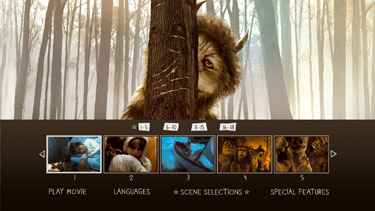 |
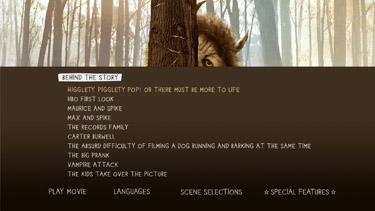 |
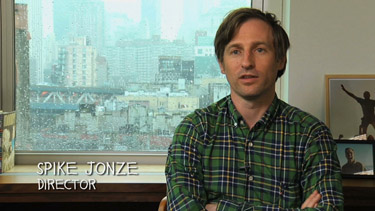 |
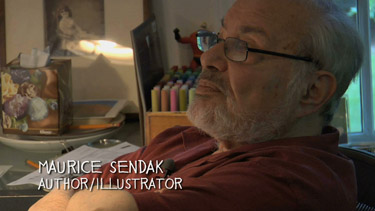 |
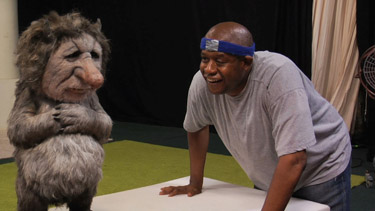 |
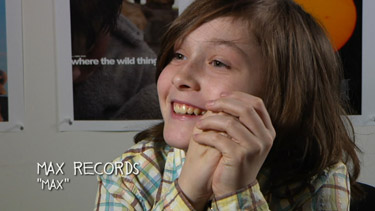 |
Bottom line:
6
I imagine that Where the Wild Things Are is one of those
movies you either warm to or you don't. My own experience
was as much interfered with by technical matters as much as
text. I found the high def image to be difficult to get a
handle on, whereas the audio was awesome. The discrepancy
worked against itself for me. I wonder if my negative
response to Jonze's notion about the function of fantasy can
be moderated by a second viewing. The extra features are
most enjoyable. Unless you already have you're mind made up,
I suggest a rental first.
Leonard Norwitz
February 27th, 2010
|
![]()
![]()

![]()
![]()
![]()
![]()

![]()
![]()

